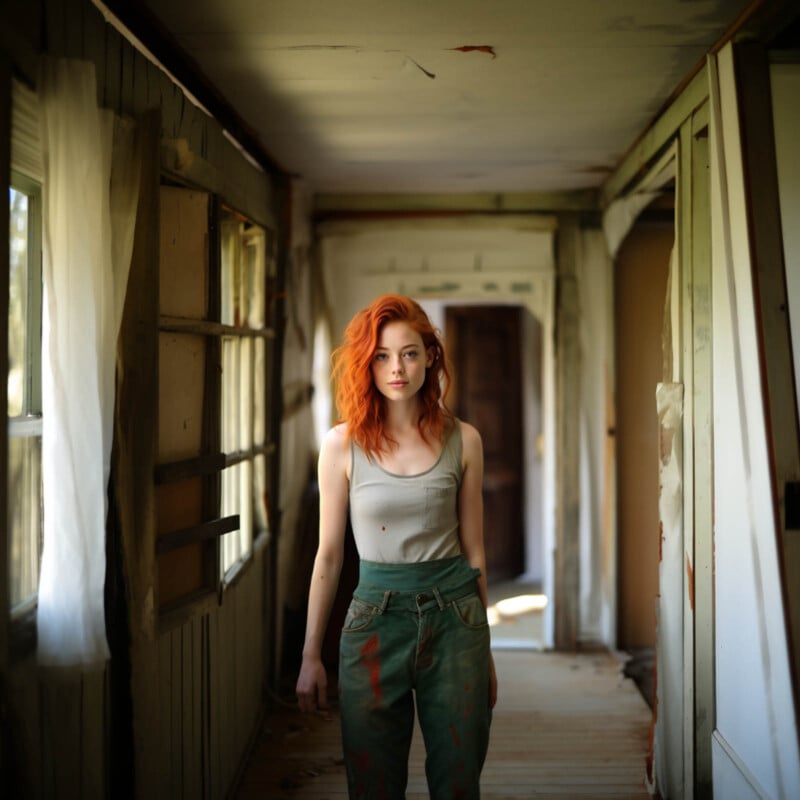Does The World Need Images of Fake A.I. People?

We have all heard the arguments for and against A.I. imagery from the perspective of photographers. By now, most of us realize that these images are not photographs but some sort of graphic design created by artificial intelligence.
We continue to see these images make their way into every nook and cranny of the internet. Advertisers are saving a buck by forgoing models, wardrobe, make-up, props, and even sets. If we have learned one thing from the past is that the key reason for the adoption of new technologies is to save money and time. This is all well and good but there is a new wrinkle that has developed in regards to A.I. portraiture.
![]()
Meet Mia Gezelleg. She has thousands of followers and tens of thousands of interactions on social media. She states in her bio “I’m a digital being looking to bring happiness into the digital world.” She responds back to every compliment and men are in a frenzy over her likeness. Comments like “You look beautiful,” “I wish you were my girlfriend” and “Just smile, there is nothing better than a smiling pretty woman” are commonplace in her thread.
The problem is, she is A.I. and she does not exist, has not existed, and will never exist. Only in her bio is she disclosing this truth. She is an amalgamation of billions of other portraits that the algorithms trained upon. She is a figment of the imagination created on the backs of other photographer’s works. She has other A.I. friends who are following her and helping her perpetuate her persona and deceit. Another A.I. girl recently said to her “How fascinating you are, you deserve all the best”.
Mia may be upfront about her A.I. origins but there are thousands of other “virtual” women who are going out of their way to keep the deception a secret. A simple search for #virtualmodel reveals 134,008 posts, which gives us a glimpse into the problem. We must ask ourselves, where will this all lead?
Let me predict where this is headed. Mia or another fake A.I. persona will star in a major motion picture. If you watch the new Indiana Jones, there is no reason Mia cannot take a leading role. She may write songs, make art, get married, and even have children. Mia can be a swimsuit model 100 years from now. She also has a Patreon account where you can buy her a coffee or send her a present from her Wishlist. For an additional $8 you can enter a virtual area where you can see nude imagery of Mia and her friends. A girl has got to make a living, right? How convenient for her creators.
![]()
How has this become a thing? This problem becomes rather dystopian because of a longstanding issue with the internet, anonymity. You see at some point in the not-so-distant past it became acceptable to have an opinion or have a presence online without identifying who you are. Previously we used words like impersonation, disguise, or even identity theft to describe such behaviors and tactics. Now we all just accept this as a byproduct of the online world and nobody needs to be who they say they are.
With this ability to be anonymous, how can someone be held accountable for their actions? Sure, some of the actions may be harmless, like giving a compliment to a girl that does not exist, but what about greater concerns like identity theft and fraud?
So, a new technology comes along that allows us to quickly make photograph-like imagery of people, people who have never existed. We quickly end up with Mia and her ilk. Who is to say who Mia really is? Is she an 80-year-old grandma playing around on her iPad? Is she a middle-aged overweight bald man trying to make some additional income or is she just a 13-year-old gamer who does this after school for fun? The fact is, nobody knows.
There seems to be too many people falling for this illusion, this dream of perfection that does not exist. The Association of Certified Fraud Examiners states that A.I. does not only create fake portraits, but video, audio files and voice-overs as well.
Thieves are now training A.I. on people’s voices and with remarkable accuracy. These new systems are already making phone calls to family and friends. They then convince them that you are in some sort of trouble and that action needs to be taken. Usually involving transferring funds for bail or to a fake attorney. Fifty-six billion dollars was lost last year to such hoaxes and scams.
Yes, that was billion with a “B”.
So, what can be done? First, there needs to be a concerted effort that does not allow people to have anonymity. This includes all social media sites like Facebook, Instagram, TikTok, and X, formerly known as Twitter. Everyone needs to be verified and authenticated. This will not be easy because Facebook is allowing known users to post “anonymously” into groups, compounding the problem. X has started offering people the ability to have a paid subscription to the site. This proves to others they are real and authentic with a little verified icon next to their name. This is a start and we need more of this.
Secondly, these A.I. companies are going to need to be required to stamp their output with some sort of digital watermark so that authenticity can be verified. We need to be able to quickly identify what content can be trusted and what content is suspect. Our national security is in the balance. What would happen if a truly believable video of Vladimir Putin surfaced where he stated he just launched nuclear weapons towards America? The consequence of not knowing what is real or fake is so very important.
How can one do this without establishing gatekeepers? Is the world a better place if we only trust images from say the likes of Getty Images? Unless it comes from them, the images cannot be trusted. This is not much of a solution. Since these images can be made so quickly and without any real cost, theoretically there could be a point where there are more “fake” images online than real images. Would we have to declare bankruptcy on the internet and not rely on it for any information? If most of the text, images, and video online are not real, where would that leave us? As you can see, it is very easy to have more questions than answers when it comes to this topic.
The third action we can take is to call out A.I. images when we see them being used inappropriately. We must make a concerted effort to bring attention to these fake personalities. We must vote for leaders who understand the modern-day issue of A.I. and are willing to address this problem with legislation. The world relies on the modern-day internet to such an extent that we simply cannot allow it to be ruined by a huge influx of bogus and fake information.
You see, it has long been the position of the U.S. Copyright Office to not offer protection for works created by non-humans, including machines. Therefore, the images of Mia cannot be copyrighted and we have no worries about displaying them in this article. It is yet to be seen if not having such intellectual property protection hinders the creators of such A.I. content going forward.
So, I wanted to try a little experiment. I wanted to see how difficult it was to steal the likeness of Mia using A.I. similar to the one she was generated with. I asked my good friend Steve Lease to see how quickly he could generate her using A.I. He was able to create his own version of Mia in a matter of minutes. Just for fun, I asked him to put her in a rundown house. It is a shame that she squandered her ill-gotten gains and did not prepare for her future. But I digress.

We must understand that we take photographs to document history and who we are today. These artificial creations pose a tangible threat to real history in a way that we have never seen before. The first step to mitigating any problems is being aware of the dangers such images pose to our culture and history.
Fantasies… who needs fantasies? I have memories. ―B.J. Neblett
This is Shane’s 4th article of his series on A.I. The other three articles are:
- A.I. Imagery Is Not Photography, It Never Will Be
- AI Imagery May Destroy History As We Know It
- Art and A.I.: Debating the Definition of Creativity
About the author: Shane Balkowitsch is a wet plate collodion photographer. He has been practicing for over a decade the historic process given to the world by Frederick Scott Archer in 1851. He does not own a digital camera and analog is all that he knows. He has original plates at 71 museums around the globe including the Smithsonian, Library of Congress, The Pitt Rivers Museum at the University of Oxford, and the Royal Photographic Society in the United Kingdom. He is constantly promoting the merits of analog photography to anyone who will listen. His life’s work is “Northern Plains Native Americans: A Modern Wet Plate Perspective” a journey to capture 1,000 Native Americans in the present day in the historic process.